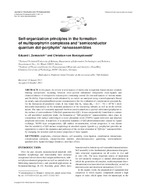Self-organization principles in the formation of multiporphyrin complexes and “semiconductor quantum dot-porphyrin” nanoassemblies
Bibliographic entry
Zenkevich, E. I. Self-organization principles in the formation of multiporphyrin complexes and "semiconductor quantum dot-porphyrin" nanoassemblies / E. I. Zenkevich, C. von Borczyskowski // J. Porphyrins Phthalocyanines. – 2014. – Vol. 18. – P. 1-19.
Abstract
In this paper, we review several aspects of molecular recognition (based on non-covalent binding interactions) occurring between meso-pyridyl substituted tetrapyrrole extra-ligands and chemical dimers of tetrapyrrolic macrocycles containing central Zn ions and spacers of various nature and flexibility. Experimental results obtained by us earlier are analyzed using a novel approach (based on steady-state absorption/fluorescence measurements) for the evaluation of complexation constants KC for the formation of porphyrin triads. It was found that KC values [KC ~ (0.5 – 70) × 10⁶ M⁻¹] show noticeable dependence on the structural parameters of the interacting subunits as well as on the solvent nature. The same self-assembly approach has been used to attach meso-pyridyl substituted porphyrins to the surface of semiconductor CdSe/ZnS quantum dots (QD). It was comparatively found that in contrast to self-assembled porphyrin triads, the formation of “QD-porphyrin” nanoassemblies takes place in competition with surface stabilizing tri-n-octyl phosphine oxide (TOPO) ligand molecules and attached porphyrin molecules. It manifests in a temporal dynamics of QD photoluminescence caused by ligand exchange, TOPO layer reorganization, QD surface reconstruction, solvent properties. It was shown that the sensitivity of QD surface morphology to attached organic ligands (e.g. porphyrins) provides an opportunity to control the dynamics and pathways of the exciton relaxation in “QD-dye” nanoassemblies by changing the structure and electronic properties of these ligands.

